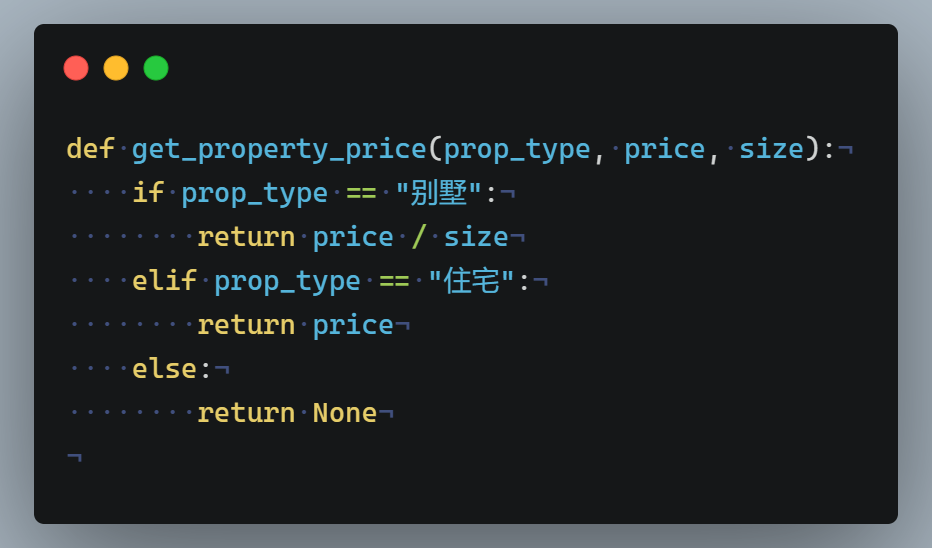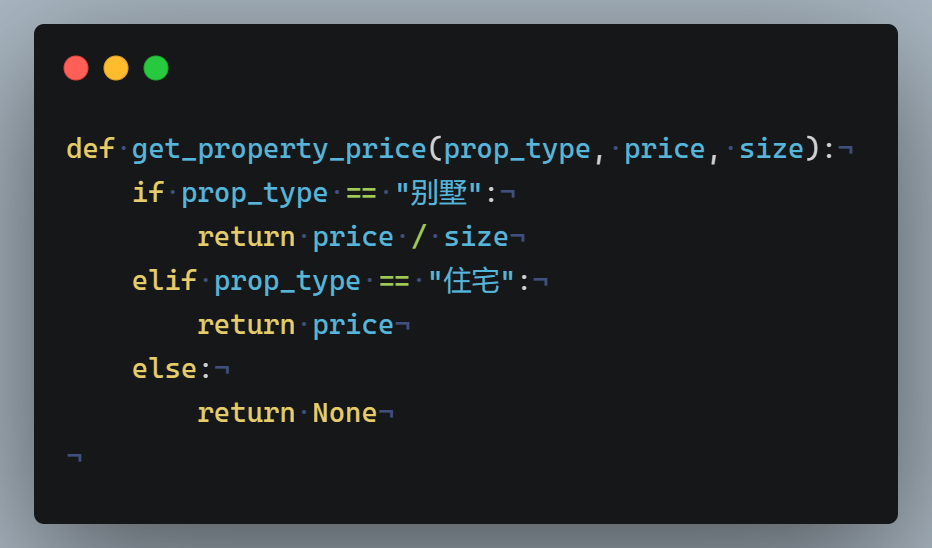def is_old_property(built_year, current_year=2024):
if (current_year - built_year) > 10:
return "aged10"
else:
return "new"
is_old_property(2010)'aged10'如果程序需要根据一定条件执行不同的操作,就需要使用条件语句
condition 条件表达式的结果必须是 bool 类型elif 可以有任意多个,也可以是 0 个if-else 结构可以嵌套根据二手房的建成年份判断是不是 10 年以上的老房子。 如果是,标记为
"aged10";如果不是,标记为"new"。
根据二手房的建成年份进行房龄分级。 如果是 20 年以上,标记为
"aged20"; 如果是 10 年以上,标记为"aged10"; 如果 10 年以下,标记为"new"。
上次我们定义了一个函数,根据二手房总数和每页显示的数量计算总页数。
但是有一个隐藏条件:
page_size的值不能是 0,而且一般也不能超过 20。 修改这个函数,当条件不满足时,返回 0 。
提示
and or 等。def page_num(page_size, total):
if page_size > 0 and page_size <= 20:
return total // page_size + int(total % page_size > 0)
else:
return 0
print(page_num(0, 100))
print(page_num(1000, 845))
print(page_num(20, 845))0
0
43注释
这里事实上使用 0 作为一种错误代码。 一般情况下,page_num 为 0 ,表示没有页,属于一种错误情况。 这种情况下,我们就可以停止爬虫。
Python 中通过缩进区分不同层级的代码。
: 后就表示开始一个新的层级

当 if 语句中的条件由很多部分组成时,Python 一般从左到右逐个判断。 但是当某一个语句的结果判断完成后,如果后面的判断无法改变这个结果,Python 就不再继续判断了。
or 连接,其中一个是 True 时,触发短路,结果是 Trueand 连接,其中一个是 False 时,触发短路,结果是 False这个特性可以保证可读性和正确性。
通常情况下,如果一个变量的值可以是
None,那么我们称这个变量是可空变量。 但是对于字符串,不一定只有值是None的字符串才是空字符串。 值是""的字符串实际上也是空字符串。 写一个函数,判断一个字符串实际上是不是“空”字符串。
同样的问题,但是写一个函数判断是不是非空字符串。
如果要对一组变量执行同样的操作,可以使用循环语句。 循环语句有两种,for 循环和 while 循环。
For 循环又称“迭代”,是最常用的一种循环。
重要
item 是循环变量,依次从 iterable 中取一个值。iterable 位置上的一定是可以迭代的。
list dict set tuple 都是可以迭代的。range 的返回值也是可以迭代的enumerate zip 的返回值也是可以迭代的现在有一批房子的建成年份,根据这些年份进行分级。
写一个函数,输出一个整数除了1和它本身以外的所有因数。
2
3
4
6
8
12当循环范围无法确定,只能确定循环执行的条件,使用 while 循环。
condition 是 True 时,执行 operations 的操作;operations 的操作,检查 condition 是否还满足;
condition 仍然满足,再次执行 operations 的操作,然后再检查;condition 不满足了,就不再执行 operations 的操作。计算一个正整数的阶乘。
120注释
计算几何级数 \(y = \sum_{i=0}^\infty \frac{1}{2^i}\) 的数值,精度为 \(1 \times 10^{-6}\)。 也就是说,当计算结果的变化不超过 \(1 \times 10^{-6}\) 时,停止计算。
循环里面也可以写循环,但是要注意循环变量不要重复。 这种循环被称为多重循环。
多重循环有的时候不得不用,但是尽量减少使用。
给定一个最大值,查找不大于该最大值的自然数中的质数。
在循环中,使用 break continue 两个关键词可以主动控制循环的走向。
break 使循环立刻终止,不再执行循环体内后面的语句,直接回到循环体外。continue 跳过这一次循环中后面的语句,直接进入下一次循环。通常和判断语句一起使用。
计算之前那个几何级数, 但是要求迭代次数不超过 10 次,如果超过了,就直接返回当前的结果。
房地产交易平台上,通常只有别墅的房价是以总价的形式显示的,其他都是按单位面积均价显示。 编写一个函数,将所有价格统一处理成单位面积均价的形式。 房地产信息由字典给出。
重要
continue 并不是总是非常必要,通过调整判断条件大多数情况下都可以避免。continue,可以减少嵌套层级。与循环语句类似,由一个叫“列表推导式”的语法,可以从一个列表得到另一个列表。 也可以设置一些条件。
上面的例子可以直接使用列表推导式
['aged20', 'aged10', 'aged10', 'aged10', 'new', 'new']重要
列表推导式非常重要!
现在有一组坐标,精确到小数点后 6 位,按照之前的方法转换成唯一标识。
给两个向量(默认为列向量),计算内积 \(\mathbf{x}^\mathrm{T} \mathbf{y}\)。 如果 \(\mathbf{x}=(x_1,x_2,\cdots,x_n)\), \(\mathbf{y}=(y_1,y_2,\cdots,y_n)\), 那么 \(\mathbf{x}^\mathrm{T} \mathbf{y} = \sum_{i=1}^n x_i y_i\)。
提示
zip 可以将两个列表并列。莱布尼兹级数 \(1 - \frac{1}{3} + \frac{1}{5} - \frac{1}{7} + \frac{1}{9} + \cdots = \frac{\pi}{4}\) 。 只计算前 100 项的和并乘以 4。
假设一个向量有 \(n\) 个元素,计算从第一个元素开始到每个元素位置的累积和。 比如,\([1,2,3]\) 的累积和是 \([1,3,6]\)。
提示
_ 表示不需要的元素。enumerate 可以获取元素的序号。类似于列表推导式,字典推导式如下
{key_operation(x): value_operation(x) for x in iterable}
{key_operation(x): value_operation(x) for x in iterable if condition}需要注意的是:
key_operation 还是 value_operation 都可以和 x 无关key_operation(x) 的结果必须是一种“可哈希”的类型,包括 int float str bool tuple 以及其他所有具有自定义哈希方法的类型。现在有一组元组构成的列表,元组有三个元素,分别表示小区名、小区均价和物业费。 为了便于读取,将元组列表转换成字典,以小区名为键,值是字典
{'avg_price': price, 'management': fee}
将字符串列表转换为字典,键是字符串,值是长度。
{'abcdefg': 7, '1927h3ksmfd': 11, '19lpwwodksj': 11}聚合查询
实际中,我们会对数据进行分组,然后计算这个组的某个指标,比如数量、平均数等。
重复元素会自动被去除。
元组推导式的结果并不是一个元组,而是一个类似于 range 的生成器,并不会立刻求值。
自定义类